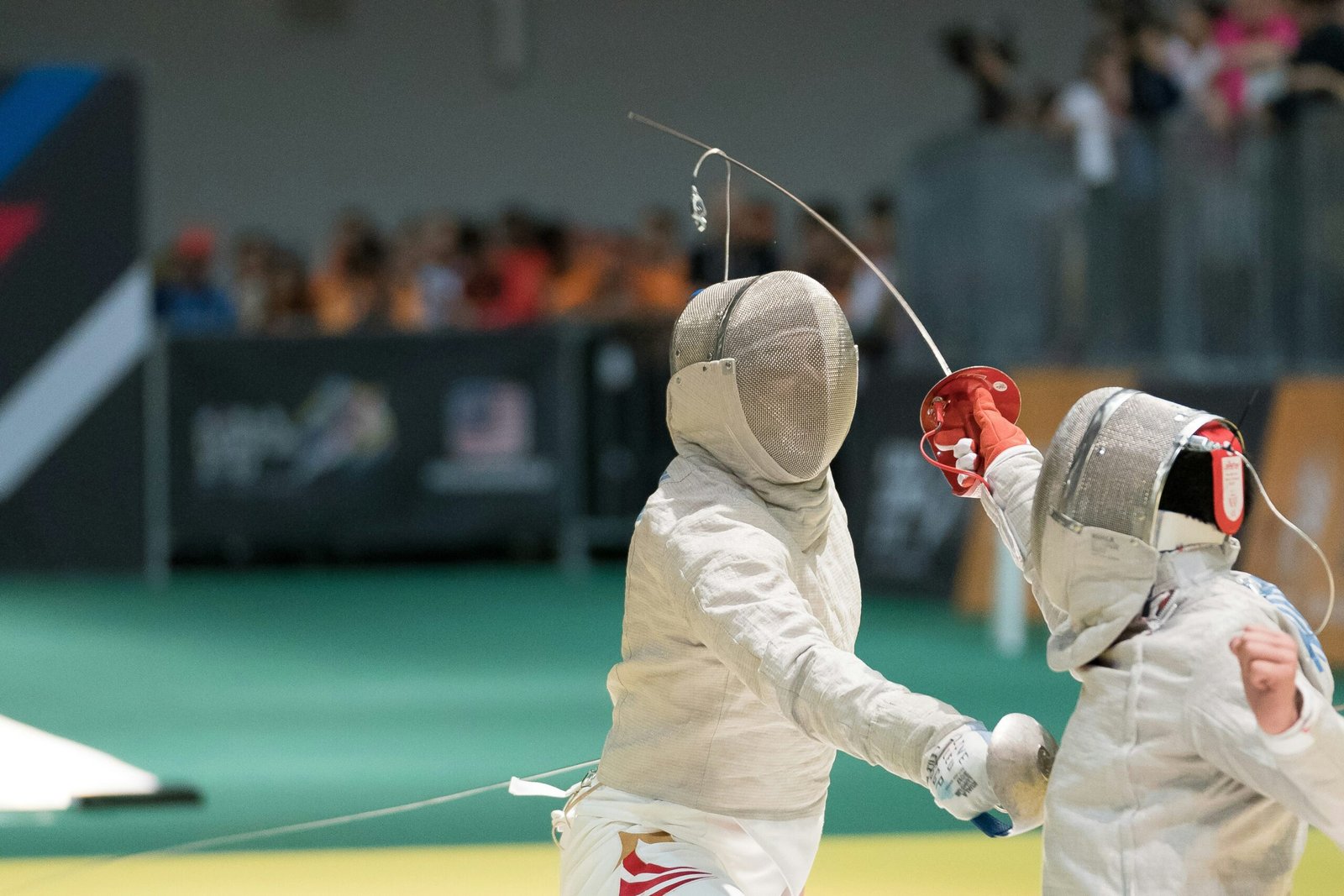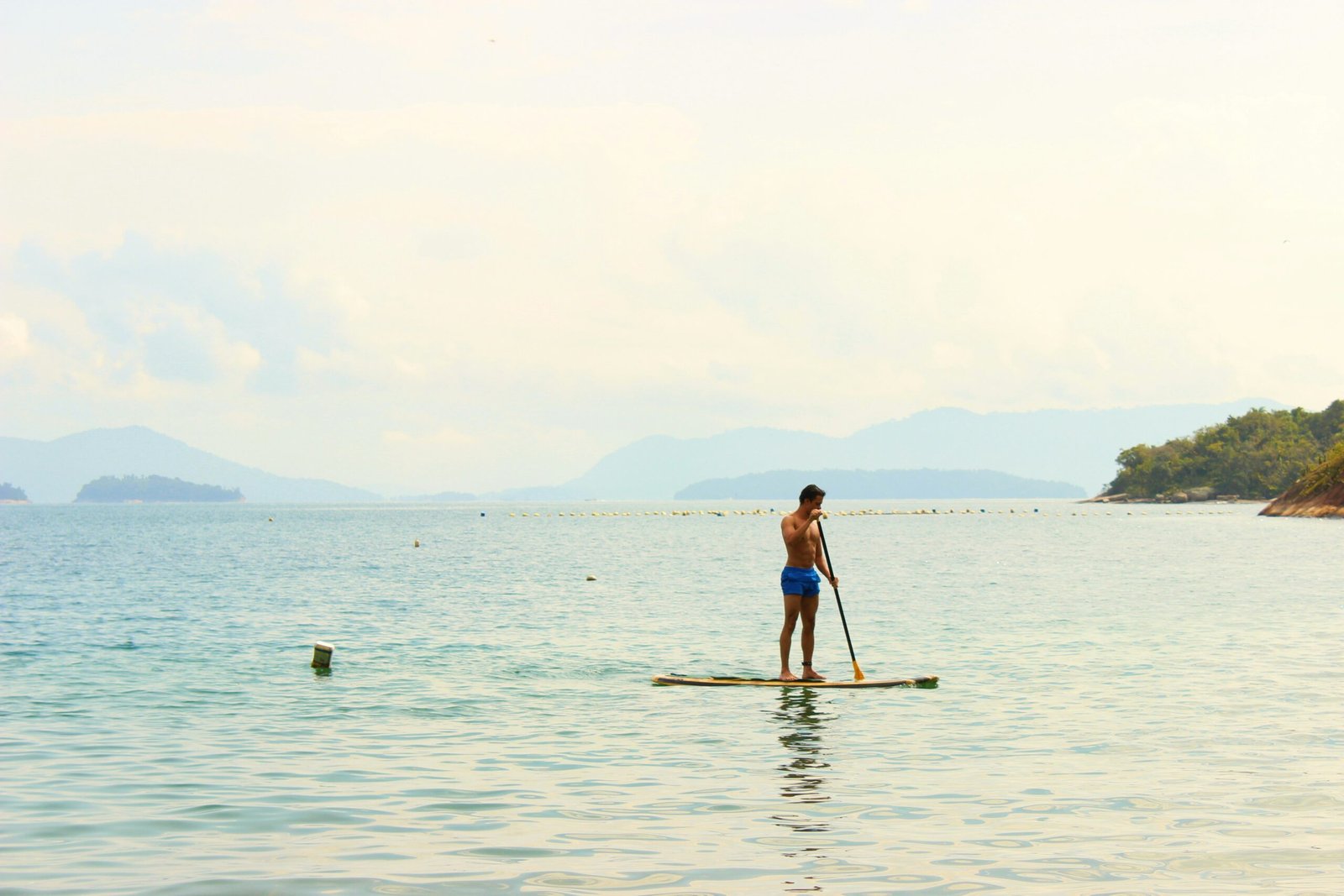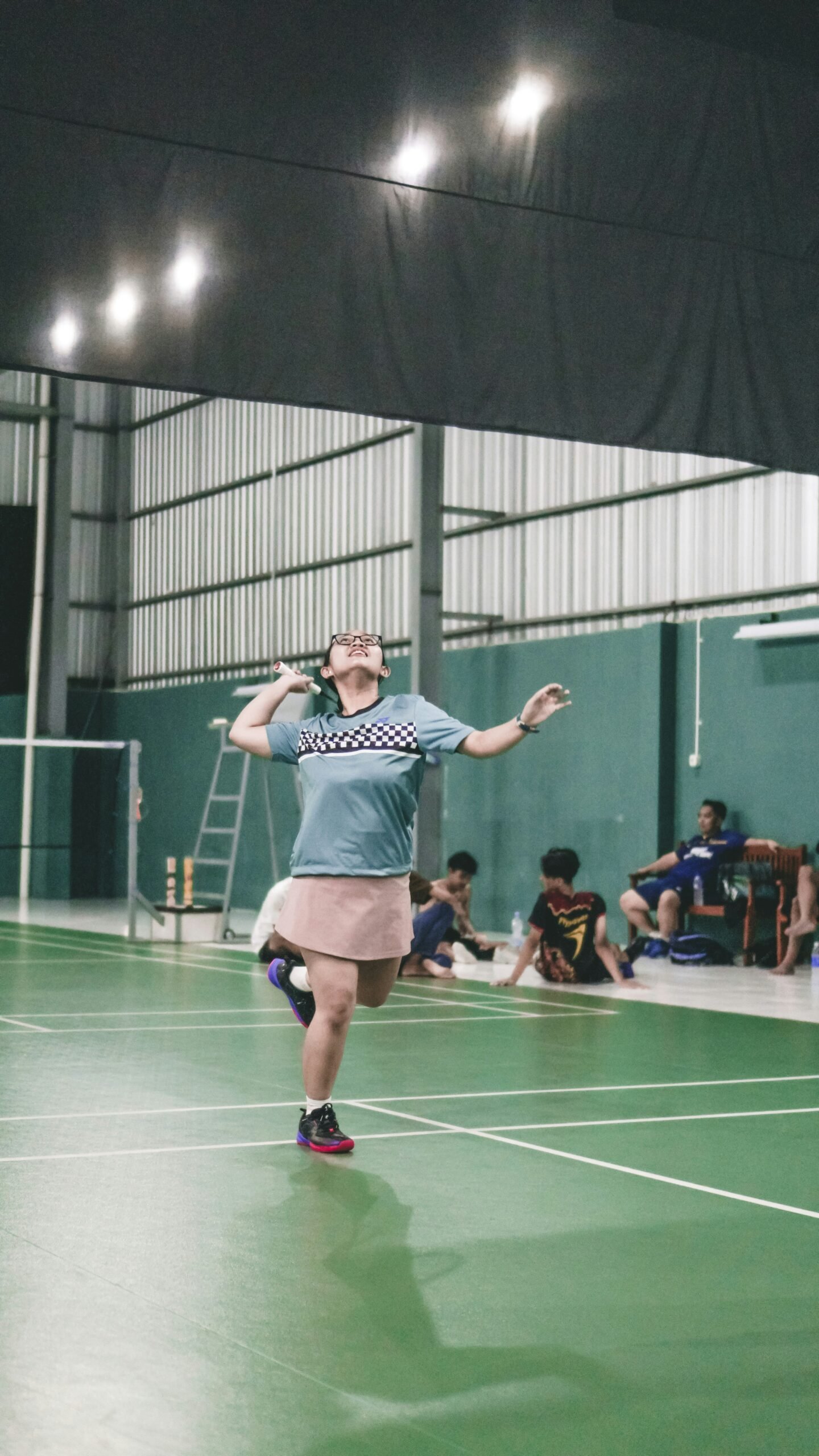What is Stand-Up Paddleboarding?
Stand-up paddleboarding (SUP) has emerged as a prominent water sport, captivating participants with its unique blend of recreation, fitness, and relaxation. Originating in the Hawaiian Islands, SUP dates back to ancient times when Polynesian surfers would use long paddles to navigate the waters while standing on their boards. In recent years, it has evolved into a modern sport, gaining popularity worldwide, particularly among outdoor enthusiasts and fitness advocates.
The fundamental concept of stand-up paddleboarding involves a participant standing on a stable board and using a long paddle to propel themselves across the water’s surface. This method clearly distinguishes SUP from other water sports such as kayaking or canoeing, wherein participants remain seated. The upright position in SUP facilitates a full-body workout, engaging core muscles, improving balance, and enhancing overall physical fitness levels.
One of the main advantages of stand-up paddleboarding is its accessibility; it can be practiced on various water types ranging from calm lakes to ocean waves. Additionally, it serves as an effective cardiovascular exercise, helping participants establish breathing techniques while encouraging mindfulness and connection to nature. These benefits contribute to the rising appeal of SUP, making it a favored choice for both casual and competitive paddlers.
Furthermore, stand-up paddleboarding offers diverse experiences, whether users are seeking leisurely paddles along scenic coastlines, intense workouts aimed at improving athletic performance, or even exciting adventures like paddleboard yoga. The adaptability of this sport allows it to cater to a wide range of preferences and skill levels, which has facilitated its growth across different demographics. Overall, the blend of fitness, enjoyment, and the tranquility associated with water-based activities makes stand-up paddleboarding a compelling option for many individuals looking to explore the aquatic world.
Essential Gear and Equipment for SUP
Embarking on the journey of stand-up paddleboarding (SUP) requires an understanding of the essential gear that will enhance your experience on the water. One of the most significant choices is selecting the type of board. There are primarily two types: inflatable boards and hard boards. Inflatable boards are portable, lightweight, and convenient for storage, making them an excellent option for beginners and those with limited space. Conversely, hard boards offer superior stability and performance on the water, often favored by seasoned paddlers for racing or surfing. Your choice should align with your skill level and intended use.
Next, choosing the right paddle is crucial. Paddles vary in material, length, and blade shape. For novices, a lightweight paddle made from aluminum or fiberglass is recommended. The ideal length of the paddle should be approximately 6 to 8 inches taller than your height, allowing for optimal reach and ease of stroke. Blade shape also plays a role; a broader blade aids in power, while a narrower blade can enhance speed and efficiency.
Safety is paramount when participating in any water sport, and for SUP, a Personal Flotation Device (PFD) is essential. Many states mandate the use of a PFD, which can be either a life jacket or a less bulky belt-style device. Additionally, a leash is an important accessory that keeps you connected to your board, preventing it from drifting away if you fall off.
Further accessories include sun protection gear such as sunscreen, sunglasses, and hats, which are essential for safeguarding against UV rays. A hydration system, whether a bottle or a hydration pack, ensures that you stay hydrated during your time on the water. Overall, investing in the right gear not only enhances your enjoyment of paddleboarding but also ensures your safety as you develop your skills.
Choosing the Right Location for SUP
Choosing the right location for stand-up paddleboarding (SUP) is essential for beginners seeking a safe and enjoyable experience. Various factors influence the selection of a paddling location, including water conditions, weather, and the accessibility of the site. For novice paddlers, it is crucial to seek areas with calm waters, as turbulent conditions can lead to difficulties in balance and stability. Ideal settings include tranquil lakes and slow-moving rivers, where paddlers can develop their skills without the added challenge of strong currents or waves.
When considering a suitable spot for SUP, it is vital to assess the weather conditions. Beginners should aim to paddle during periods of mild weather, avoiding strong winds or storms that could create hazardous conditions. Additionally, factors such as temperature and potential exposure to sunlight should be taken into account to ensure comfort and safety during paddling sessions.
Accessibility to the chosen paddling location is another crucial element. It is advisable to select areas that offer convenient entry and exit points, allowing beginners to launch their boards easily without needing excessive physical exertion. Facilities such as nearby parking, restrooms, and rental services can enhance the overall experience, making the day more enjoyable.
Safety plays a paramount role in any water-based activity, particularly for those just starting. It is recommended for beginners to familiarize themselves with local regulations and guidelines governing paddling activities. Many areas have designated zones for SUP, and adhering to these rules ensures responsible paddling practices. Furthermore, being aware of any potential hazards, such as wildlife or underwater obstructions, can help prevent accidents. In light of these considerations, selecting the right location for stand-up paddleboarding can significantly enhance the experience and support skill development in a safe manner.
Basic Techniques and Safety Tips
Embarking on your stand-up paddleboarding (SUP) journey requires a solid foundation in basic techniques and safety measures. To begin with, standing on the board correctly is crucial. Position your feet shoulder-width apart, with your toes pointed towards the front of the board. Engage your core for stability, and keep your knees slightly bent. This stance will provide a strong base, allowing you to maintain balance as you start paddling.
When it comes to paddling strokes, mastering the correct technique will enhance your efficiency on the water. Start with a proper grip on the paddle, utilizing your top hand to steer and your bottom hand to guide the stroke. Engage your core as you reach the paddle forward and pull it back along the side of the board, ensuring the blade remains perpendicular to the water for maximum propulsion. To turn, simply use a sweeping stroke on one side of the board, which will pivot your direction smoothly.
Stopping is just as important as moving forward. To slow down, you can drag the paddle in the water alongside the board or perform a wide, sweeping stroke on either side to bring your speed down gradually. Remember that practice makes perfect; don’t hesitate to familiarize yourself with these movements in calm water before venturing out into more challenging conditions.
Equally vital are the safety tips associated with SUP activities. Always wear a life jacket, as it enhances your safety, providing buoyancy in case of a fall. When you do fall, aim to land in the water away from your board to prevent injury. Lastly, always remain aware of other watercraft and navigational markers, ensuring a safe and enjoyable experience for everyone on the water.
Warm-Up and Stretching Exercises
Before embarking on your stand-up paddleboarding (SUP) adventure, it is crucial to engage in a series of warm-up and stretching exercises. These routines not only prepare your body for the physical demands of paddling but also significantly reduce the likelihood of injuries, enhancing your overall experience on the water. A careful warm-up engages key muscle groups, which is essential for optimizing performance and ensuring safety.
To begin, focus on dynamic stretches that activate your legs, arms, core, and back. For the legs, consider performing leg swings; by standing on one leg and swinging the other forward and backward, you warm up the hip flexors and hamstrings. Next, try quad stretches by pulling one foot towards your glutes while standing. This movement ensures that the quadriceps are appropriately prepared for physical activity.
For the upper body, arm circles serve as an excellent dynamic stretch. Extend your arms out to the sides and rotate them in small circles, gradually increasing the size of the circles to warm up the shoulders and improve mobility. Additionally, torso twists can be beneficial for engaging your core and back. Stand with your feet shoulder-width apart, then twist your upper body from side to side, allowing your arms to follow the motion.
Moreover, incorporate some gentle lunges to enhance leg flexibility and strength. Step forward with one leg and lower your hips until both knees are bent at about a 90-degree angle. This exercise activates multiple muscle groups and creates stability. Lastly, incorporate deep breathing during these activities—each inhale and exhale aids in loosening the muscles and centers your focus.
By dedicating time to these warm-up and stretching exercises, beginners will find themselves better prepared for the exciting challenge of paddleboarding. As a result, they can enjoy a more dynamic and injury-free experience on the water.
Common Beginner Mistakes and How to Avoid Them
Paddleboarding is an enjoyable and invigorating activity, but beginners often encounter a range of common mistakes that can hinder their learning curve and overall experience. Understanding these pitfalls and how to avoid them can significantly enhance your time on the water. Among the most frequent errors is improper paddling technique. Many novice paddleboarders tend to overreach or use excessive force while paddling, which not only waste energy but can also lead to quicker fatigue. A proper technique involves keeping the paddle close to the board and using the core muscles rather than relying solely on the arms. Practicing smooth, consistent strokes helps maintain momentum and efficiency.
Another mistake beginners make is poor balance. Balance is vital when stand-up paddleboarding, influencing your ability to stay upright and navigate effectively. Novice paddlers often stand too rigidly or distribute their weight unevenly, which can lead to unsteadiness. To improve balance, beginners should focus on bending their knees slightly and adopting a relaxed stance. Engaging the core muscles and keeping the feet parallel and shoulder-width apart also fosters better balance. Furthermore, practicing on calmer waters before progressing to choppier conditions can benefit beginners immensely.
Finally, many novice paddleboarders underestimate the impact of water conditions. Factors such as wind, current, and wave size can significantly affect a beginner’s stability and overall experience. Beginners should always check the weather forecast and understand local water conditions before heading out. It is advisable to start during ideal conditions, such as mild winds and calm waters, to maintain a positive feeling about paddleboarding. By being mindful of these common beginner mistakes and implementing preventative measures, new paddleboarders can enhance their learning experience and enjoyment on the water.
Joining the Paddleboarding Community
Engaging with the paddleboarding community can significantly enhance both the enjoyment and proficiency of your stand-up paddleboarding (SUP) experience. By joining local SUP clubs or organizations, you benefit from a social network that shares your passion. These groups often provide a welcoming environment for beginners, enabling newcomers to learn from more experienced paddleboarders. The friendships formed in these clubs can also lead to lively discussions about techniques, gear, and locations, which enriches the entire paddleboarding experience.
Moreover, participating in community events can expose you to various paddling styles and disciplines, such as racing, touring, or yoga on the water. Such exposures can motivate you to try new things within the sport, broadening your paddleboarding horizons. Many clubs also offer workshops, clinics, and group outings, which not only provide hands-on learning experiences but also foster camaraderie among members. These group outings often take place at picturesque water locations, giving participants an opportunity to explore new environments while paddleboarding.
Finding local SUP groups can be a straightforward process. Many communities have social media pages dedicated to paddleboarding, where enthusiasts share events, tips, and get-togethers. Websites like Meetup.com and Facebook events can be excellent resources for locating nearby clubs or informal gatherings. Additionally, local sporting stores or rental shops may offer bulletin boards with information on upcoming paddleboarding activities. Engaging in these groups not only keeps you motivated but also allows you to contribute to a collective love for paddleboarding. Through shared experiences, you will build lasting memories and friendships while continuously improving your skills on the water.
Advanced Techniques and Progressing Your Skills
As beginners gain confidence in stand-up paddleboarding (SUP), they may wish to enhance their skills and explore advanced techniques. Progression in this sport is essential not only for personal development but also for increasing enjoyment and enabling participation in diverse paddleboarding disciplines. Understanding various paddling styles can help paddleboarders discover what resonates with them the most.
One area to explore is racing, where participants can compete against others, enhancing both speed and technique. Learning efficient paddle strokes and mastering balance are crucial for success in competitive settings. Beginners might start by participating in local races or time trials to develop their skills progressively.
Another captivating style is yoga on the paddleboard. Practicing yoga while balancing on a SUP engages the core and improves stability. Classes or workshops tailored towards paddleboard yoga can provide helpful guidance and foster a sense of community among participants.
Paddleboarding for fishing is also growing in popularity, as it allows anglers to access hard-to-reach locations with ease. Interestingly, fishing from a SUP necessitates distinct techniques, such as maintaining balance while casting, which can be developed through practice. It is advisable to start with calm waters and work up to more challenging environments.
Furthermore, practicing in different conditions can significantly enhance overall skills. Beginners should aim to paddle in various environments, including lakes, rivers, and ocean conditions. Each environment presents unique challenges and will help paddlers adapt their technique and response to the water.
As you embark on your journey toward advanced stand-up paddleboarding skills, setting personal goals can provide direction and motivation. Whether aiming to participate in a race, perfect a yoga pose, or master fishing techniques, consistent practice and an open mindset will facilitate continuous improvement.
Conclusion and Next Steps
In conclusion, stand-up paddleboarding (SUP) offers an exciting and fulfilling way to engage with the water while promoting physical fitness. Throughout this guide, we have explored the essential equipment needed for beginners, discussed basic techniques for balancing and paddling, and highlighted safety tips to ensure a secure and enjoyable experience. Understanding these key aspects paves the way for a rewarding introduction to SUP.
For those eager to embark on their stand-up paddleboarding journey, the first step is to become familiar with the various types of boards and paddles available on the market. Investing in the right equipment is vital not only for performance but also for enhancing comfort on the water. Consider renting gear from a local outfitter before purchasing, as this allows you to experiment with different styles and sizes to find what suits you best.
Once you feel confident with your setup, seek out calm waters such as lakes, rivers, or bays where you can safely practice your skills. Connecting with local SUP clubs or groups can also provide invaluable support as you learn and share experiences with fellow enthusiasts. Additionally, many communities offer lessons and guided tours, which can significantly enhance your confidence and capabilities.
As you progress, consider expanding your paddleboarding activities by exploring different water regions, such as coastal areas or tranquil beaches. Each environment offers unique challenges and experiences, encouraging growth in your skills while affirming your love for this versatile sport. Remember to continually prioritize safety by adhering to weather conditions, wearing personal flotation devices, and being aware of your surroundings.
Ultimately, stand-up paddleboarding can transform into a lifelong passion that fosters a deep appreciation for nature, personal well-being, and community. So grab your paddle, embrace the journey, and enjoy the countless adventures that await you on the water.






+ There are no comments
Add yours